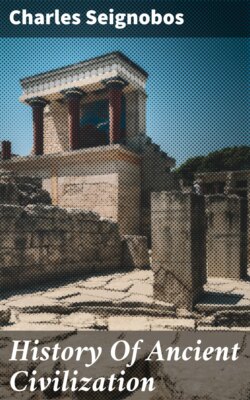Читать книгу History Of Ancient Civilization - Charles Seignobos - Страница 23
На сайте Литреса книга снята с продажи.
THE ARTS
ОглавлениеIndustry.—The Egyptians were the first to practice the arts necessary to a civilized people. From the first dynasty, 3,000[13] years B.C., paintings on the tomb exhibit men working, sowing, harvesting, beating and winnowing grain; we have representations of herds of cattle, sheep, geese, swine; of persons richly clothed, processions, feasts where the harp is played—almost the same life that we behold 3,000 years later. As early as this time the Egyptians knew how to manipulate gold, silver, bronze; to manufacture arms and jewels, glass, pottery, and enamel; they wove garments of linen and wool, and cloths, transparent or embroidered with gold.
Architecture.—They were the oldest artists of the world. They constructed enormous monuments which appear to be eternal, for down to the present, time has not been able to destroy them. They never built, as we do, for the living, but for the gods and for the dead, i.e., temples and tombs. Only a slight amount of débris is left of their houses, and even the palaces of their kings in comparison with the tombs appear, in the language of the Greeks, to be only inns. The house was to serve only for a lifetime, the tomb for eternity.
Tombs.—The Great Pyramid is a royal tomb. Ancient tombs ordinarily had this form. In Lower Egypt there still remain pyramids arranged in rows or scattered about, some larger, others smaller. These are the tombs of kings and nobles. Later the tombs are constructed underground, some under earth, others cut into the granite of the hills. Each generation needs new ones, and therefore near the town of living people is built the richer and greater city of the dead (necropolis).
Temples.—The gods also required eternal and splendid habitations. Their temples include a magnificent sanctuary, the dwelling of the god, surrounded with courts, gardens, chambers where the priests lodge, wardrobes for his jewels, utensils, and vestments. This combination of edifices, the work of many generations, is encircled with a wall. The temple of Ammon at Thebes had the labors of the kings of all the dynasties from the twelfth to the last. Ordinarily in front of the temple a great gate-way is erected, with inclined faces—the pylone. On either side of the entrance is an obelisk, a needle of rock with gilded point, or perhaps a colossus in stone representing a sitting giant. Often the approach to the temple is by a long avenue rimmed with sphinxes.
Pyramids, pylones, colossi, sphinxes, and obelisks characterize this architecture. Everything is massive, compact, and, above all, immense. Hence these monuments appear clumsy but indestructible.
Sculpture.—Egyptian sculptors began with imitating nature. The oldest statues are impressive for their life and freshness, and are doubtless portraits of the dead. Of this sort is the famous squatting scribe of the Louvre.[14] But beginning with the eleventh dynasty the sculptor is no longer free to represent the human body as he sees it, but must follow conventional rules fixed by religion. And so all the statues resemble one another—parallel legs, the feet joined, arms crossed on the breast, the figure motionless; the statues are often majestic, but always stiff and monotonous. Art has ceased to reproduce nature and is become a conventional symbol.
Painting.—The Egyptians used very solid colors; after 5,000 years they are still fresh and bright. But they were ignorant of coloring designs; they knew neither tints, shadows, nor perspective. Painting, like sculpture, was subject to religious rules and was therefore monotonous. If fifty persons were to be represented, the artist made them all alike.
Literature.—The literature of the Egyptians is found in the tombs—not only books of medicine, of magic and of piety, but also poems, letters, accounts of travels, and even romances.
Destiny of the Egyptian Civilization.—The Egyptians conserved their customs, religion, and arts even after the fall of their empire. Subjects of the Persians, then the Greeks, and at last of the Romans, they kept their old usages, their hieroglyphics, their mummies and sacred animals. At last between the third and second centuries A.D., Egyptian civilization was slowly extinguished.
